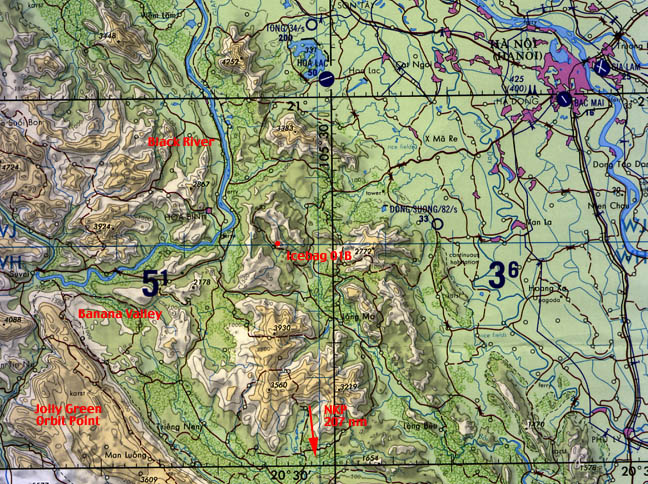
Background (Information from Scope Systems - Any Day)
In the spring of 1972, the U.S. formulated the LINEBACKER offensive. Its objective was to keep the weapons of war out of North Vietnam. At this time, the North Vietnamese had one of the best air defense systems in the world, with excellent radar integration of SA-2 SAMs, MiGs, and antiaircraft artillery. The NVN defense system could counter our forces from ground level up to nineteen miles in the air. MiG fighters were on ready alert, and after takeoff, were vectored by ground-control radar. Soviet advisors devised attack strategies, manned a number of the SAM sites, and also trained North Vietnamese crews.
The strongest SAM reactions were reserved for defense of the most vital targets. During LINEBACKER strikes into the Hanoi/Haiphong area, it was not unusual for a U.S. force to be met by barrages of over 100 missiles. (The SA-2 SAM missile was 21 feet long.) Pilots also had to cope with the enemy's creative launch tactics.
One tactic used by the North Vietnamese was the employment of barrage firings of unguided SAMs, which distracted and harassed aircrews both over the target and while MiGs positioned themselves for rear attacks.
The success of this tactic was demonstrated on May 11, 1972, when an F-105G was shot down. A barrage of six SAMs diverted the attention of the Iron Hand flight while MiGs attacked from the rear. Maj. William H. Talley, pilot of the aircraft, and Maj. James P. Padgett, electronic warfare officer, successfully ejected from the aircraft about 25 miles southwest of Hanoi and were captured by the North Vietnamese.
Situation
Icebag was down approximately 25 nm west southwest of Hanoi. Although a densely populated area, the survivor was in some high terrain in thick jungle. This allowed him to evade capture for approximately 36 hours.
Shortly after the shootdown of Icebag 01 on 11 May, both crewmembers established survival radio contact with one another on the ground. Both Icebag 01 'Alpha' (the pilot), and Icebag 01 'Bravo' (the backseater), sought to hide themselves and prepared to communicate with the rescue forces that they assumed would be arriving shortly.
Unbeknownst to them however, was the fact that there would be no attempt at a rescue on the first afternoon. The long distance from NKP to the survivors' location would make it impossible to orchestrate an attempt on this first day. All efforts were pointed toward an attempt early in the morning on the second day, 12 May.
During the morning of 12 May, Icebag 01A found it increasingly difficult to stay hidden and he was located by search parties and taken captive before the arrival of the SAR force. Icebag 01B was in a slightly better location and he was able to evade capture for another 24 hours. He reported that at one point, searchers came, "within half a shoelace of finding me," on that second day, 12 May 1972.
The SAR force arrived and immediately established radio contact with Icebag 01B. All attempts to contact 01A were without success.
The tape begins as Sandy 01-02 are attempting to locate Icebag 01B. Sandy 03-04 are escorting the Jolly Green HH-53 rescue helocopters and are orbiting about 20 nm southwest of the survivor's location.

The Players
Icebag 01A - Maj William Talley (not on tape) (POW, released in 1973)
Icebag 01B - Major James P. Padgett (POW, released in 1973)
Sandy 01-02 - Captain Don Morse and Lt Byron Hukee
Sandy 03-04 - Major Don Milner and ??
Jolly Green
Laredo 17 - F-4 'Fast FAC'
Nail 39 - OV-10 FAC from NKP
(Audio tape is in mp3 format)